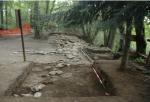Summary (English)
Excavations continued in trenches 5 and 6 and a new area, trench 9, was opened.
This project, _Indagini nell’abitato arcaico del Castelliere celto-ligure del Guardamonte _, began in 2011. As part of this project, work began on consolidating the remains in trench 5, rendering the layout of a room delimited by terrace walls comprehensible to visitors. In the 4th century and even earlier in the 6th century B.C. this terracing had enabled the inhabitants to create ample level surfaces on which to build their huts and productive areas.Also as part of the project to enhance the area for visitors, the other objective of this year’s campaign consisted in the experimental reconstruction of a pottery kiln, whose remains were excavated in previous years within the above-mentioned room.
In trench 6, US 235, a deep layer extending across the entire trench was removed. This revealed the presence of several structures proba bly connected with the use of fire, the nature of which will be investigated in coming campaigns.
Trench 9 was opened immediately north of trench 6 and east of trench 5 and covered an area of c. 2.80 × 2.90 m.
This trench was excavated in order to check for the presence and continuation of wall US 33, running on an east-west alignment in the northern part of trench 5.In the central-southern part of the trench, the upper part of a section of wall (US 324) was exposed. This was the eastern continuation of the wall in trench 5. The removal of US 323 in the south-western part of the trench, revealed a part of a new layer US 333 (to be excavated), that was yellowish in colour, and several stones perhaps relating to structure US 324.
Although the exact nature of the evidence exposed during this campaign needs further clarification, it may be assumed that it is part of the continuation of the terrace wall towards the east, as was shown by the geomorphology of the terrain.
The stratigraphic analysis confirmed the preliminary interpretations regarding the construction characteristics of the terracing in this area.
- Cristina Chiaramonte Treré - Università degli Studi di Milano
Director
Team
- Lia La Terra
- Giorgio Baratti - Università degli Studi di Milano
- Sara Menescardi
- Nicolò Donati
Research Body
- Università degli Studi di Milano, Dipartimento di Scienze dell’Antichità
Funding Body
- Regione Lombardia






![Download [PDF]](/excavation/skins/fasti/images/results/download_sml.png)